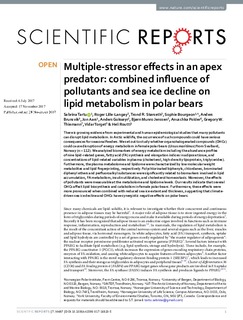| dc.contributor.author | Tartu, Sabrina | |
| dc.contributor.author | Lille-Langøy, Roger | |
| dc.contributor.author | Størseth, Trond Røvik | |
| dc.contributor.author | Bourgeon, Sophie | |
| dc.contributor.author | Brunsvik, Anders | |
| dc.contributor.author | Aars, Jon | |
| dc.contributor.author | Goksøyr, Anders | |
| dc.contributor.author | Jenssen, Bjørn Munro | |
| dc.contributor.author | Polder, Anuschka | |
| dc.contributor.author | Thiemann, Gregory W. | |
| dc.contributor.author | Torget, Vidar | |
| dc.contributor.author | Routti, Heli | |
| dc.date.accessioned | 2018-02-09T11:44:43Z | |
| dc.date.available | 2018-02-09T11:44:43Z | |
| dc.date.created | 2017-11-28T12:45:56Z | |
| dc.date.issued | 2017 | |
| dc.identifier.citation | Scientific Reports. 2017, 7 . | nb_NO |
| dc.identifier.issn | 2045-2322 | |
| dc.identifier.uri | http://hdl.handle.net/11250/2483700 | |
| dc.description.abstract | There is growing evidence from experimental and human epidemiological studies that many pollutants can disrupt lipid metabolism. In Arctic wildlife, the occurrence of such compounds could have serious consequences for seasonal feeders. We set out to study whether organohalogenated compounds (OHCs) could cause disruption of energy metabolism in female polar bears (Ursus maritimus) from Svalbard, Norway (n = 112). We analyzed biomarkers of energy metabolism including the abundance profiles of nine lipid-related genes, fatty acid (FA) synthesis and elongation indices in adipose tissue, and concentrations of lipid-related variables in plasma (cholesterol, high-density lipoprotein, triglycerides). Furthermore, the plasma metabolome and lipidome were characterized by low molecular weight metabolites and lipid fingerprinting, respectively. Polychlorinated biphenyls, chlordanes, brominated diphenyl ethers and perfluoroalkyl substances were significantly related to biomarkers involved in lipid accumulation, FA metabolism, insulin utilization, and cholesterol homeostasis. Moreover, the effects of pollutants were measurable at the metabolome and lipidome levels. Our results indicate that several OHCs affect lipid biosynthesis and catabolism in female polar bears. Furthermore, these effects were more pronounced when combined with reduced sea ice extent and thickness, suggesting that climate-driven sea ice decline and OHCs have synergistic negative effects on polar bears. | |
| dc.language.iso | eng | nb_NO |
| dc.rights | Navngivelse 4.0 Internasjonal | * |
| dc.rights.uri | http://creativecommons.org/licenses/by/4.0/deed.no | * |
| dc.title | Multiple-stressor effects in an apex predator: combined influence of pollutants and sea ice decline on lipid metabolism in polar bears | nb_NO |
| dc.type | Journal article | nb_NO |
| dc.type | Peer reviewed | nb_NO |
| dc.description.version | publishedVersion | nb_NO |
| dc.source.pagenumber | 12 | nb_NO |
| dc.source.volume | 7 | nb_NO |
| dc.source.journal | Scientific Reports | nb_NO |
| dc.identifier.doi | 10.1038/s41598-017-16820-5 | |
| dc.identifier.cristin | 1519516 | |
| dc.relation.project | Andre: Norwegian Polar Institute | nb_NO |
| dc.relation.project | Framsenteret: Fram Centre Hazardous Substances program | nb_NO |
| dc.relation.project | Norges forskningsråd: 216568 | nb_NO |
| cristin.unitcode | 7566,4,0,0 | |
| cristin.unitcode | 7401,80,1,3 | |
| cristin.unitname | Marin Ressursteknologi | |
| cristin.unitname | Massespektrometri | |
| cristin.ispublished | true | |
| cristin.fulltext | original | |
| cristin.qualitycode | 1 | |

